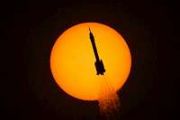
Copernical Team
FAA again delays final decision on Georgia spaceport permit

NASA’s Lucy Mission Prepares for Launch to Trojan Asteroids
 NASA has tested the functions of Lucy, the agency’s first spacecraft to study Jupiter’s Trojan asteroids, filled it with fuel, and is preparing to pack it into a capsule for launch Saturday, Oct. 16.
NASA has tested the functions of Lucy, the agency’s first spacecraft to study Jupiter’s Trojan asteroids, filled it with fuel, and is preparing to pack it into a capsule for launch Saturday, Oct. 16. The Moon in better sight

People with sight loss and sensory disabilities often experience problems seeking information online. ESA is bringing the Moon closer to them with a more accessible series of infographics.
NASA's Lucy mission to probe Jupiter's mysterious Trojan asteroids

NASA is poised to send its first spacecraft to study Jupiter's Trojan asteroids to glean new insights into the solar system's formation 4.5 billion years ago, the space agency said Tuesday.
The probe, called Lucy after an ancient fossil that provided insights into the evolution of human species, will launch on October 16 from Cape Canaveral Space Force Station in Florida.
Its mission is to investigate the group of rocky bodies circling the Sun in two swarms, one preceding Jupiter in its orbital path and the other trailing behind it.
Space Station port relocation explained – French with English subtitles
 Video:
00:03:20
Video:
00:03:20
ESA astronaut Thomas Pesquet is on his second mission to the International Space Station called Alpha. In this video Thomas explains the process behind relocating the SpaceX Crew Dragon Endeavour to another port on the Space Station.
NASA astronauts Megan McArthur, Shane Kimbrough, JAXA astronaut Aki Hoshide and Thomas flew to the International Space Station in Crew Dragon Endeavour as part of Crew-2. On 21 July the four astronauts got into their spacesuits and took their Dragon spacecraft for a spin to undock from the forward port of Harmony and redocked with the same module on another port.
Europe night timelapse
 Video:
00:01:11
Video:
00:01:11
Timelapse video made during ESA astronaut Thomas Pesquet’s second mission to the International Space Station, “Alpha”. The camera is setup to take pictures at intervals of two a second, and the pictures are then edited into this video that plays at 25 pictures a second. The video is around 12 times faster than real speed.
Thomas shared this video on social media with the caption:
“Timelapse Tuesday: Approaching Europe at night, the Madeira islands seem to act as beacons that Portugal and Spain are on the horizon under the green hue of our atmosphere. The voyage continues over a
Tiger Team solves mystery of Euclid’s galaxy speed camera

When tested in space-like conditions, the instrument on ESA’s Euclid space telescope set to measure the velocities of fast-receding galaxies abruptly stopped operating. Blindsided, the mission team feared it might take weeks or even months of extra time to uncover the reason why. Then a newly-convened ESA Tiger Team came to their assistance, pinpointing the cause and keeping Euclid on its set launch schedule.
Euclid telescope ready for extreme space environment

ESA’s Euclid mission has reached a new milestone in its development with successful testing of the telescope and instruments showing that it can operate and achieve the required performance in the extreme environment of space.
China launches high-resolution Earth-observation satellite
 China launched a Kuaizhou 1A carrier rocket to place a high-resolution Earth-observation satellite in space on Monday afternoon, according to China Aerospace Science and Industry Corporation.
The State-owned space contractor said in a statement the solid-propellant rocket blasted off at 2:19 pm at the Jiuquan Satellite Launch Center in northwestern China and soon deployed the satellite - J
China launched a Kuaizhou 1A carrier rocket to place a high-resolution Earth-observation satellite in space on Monday afternoon, according to China Aerospace Science and Industry Corporation.
The State-owned space contractor said in a statement the solid-propellant rocket blasted off at 2:19 pm at the Jiuquan Satellite Launch Center in northwestern China and soon deployed the satellite - J NASA drought research shows value of both climate mitigation and adaptation
 Seasonal summer rains have done little to offset drought conditions gripping the western United States, with California and Nevada seeing record July heat and moderate-to-exceptional drought according to the National Oceanic and Atmospheric Administration (NOAA). Now, new NASA research is showing how drought in the region is expected to change in the future, providing stakeholders with crucial i
Seasonal summer rains have done little to offset drought conditions gripping the western United States, with California and Nevada seeing record July heat and moderate-to-exceptional drought according to the National Oceanic and Atmospheric Administration (NOAA). Now, new NASA research is showing how drought in the region is expected to change in the future, providing stakeholders with crucial i 






























